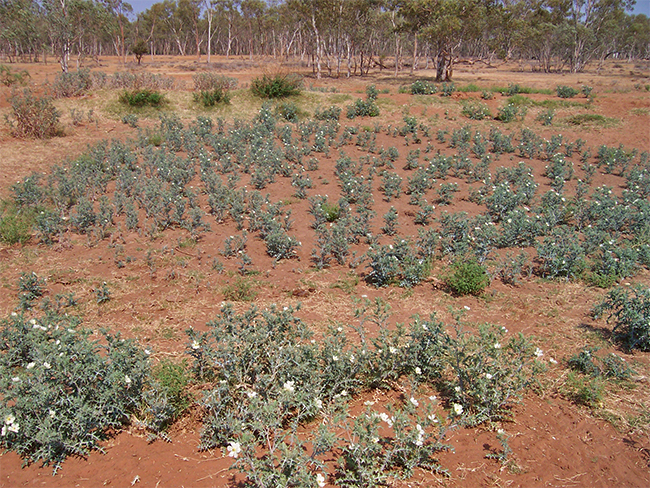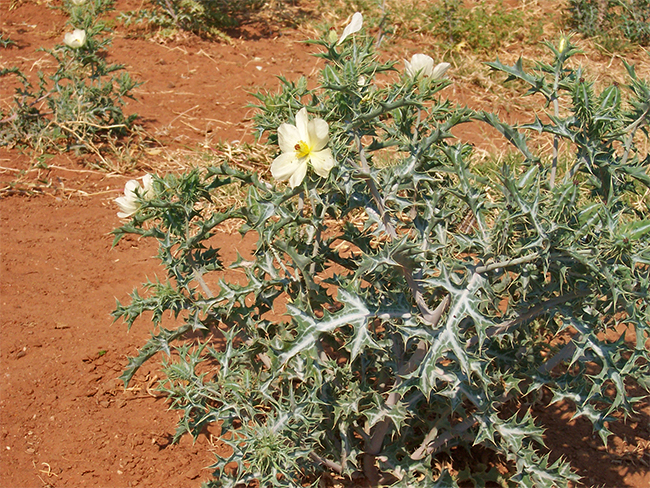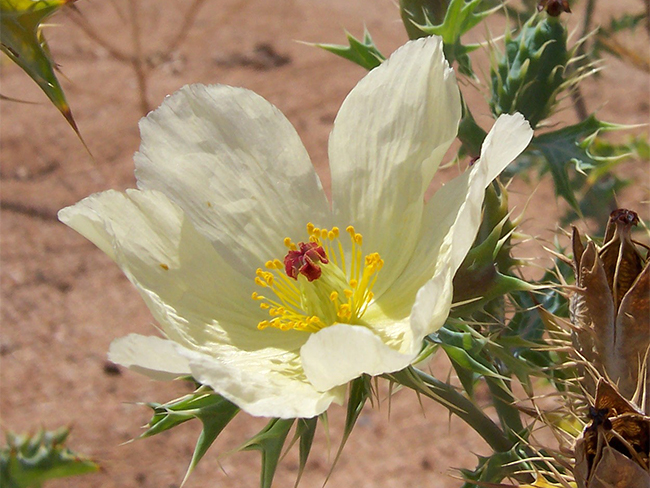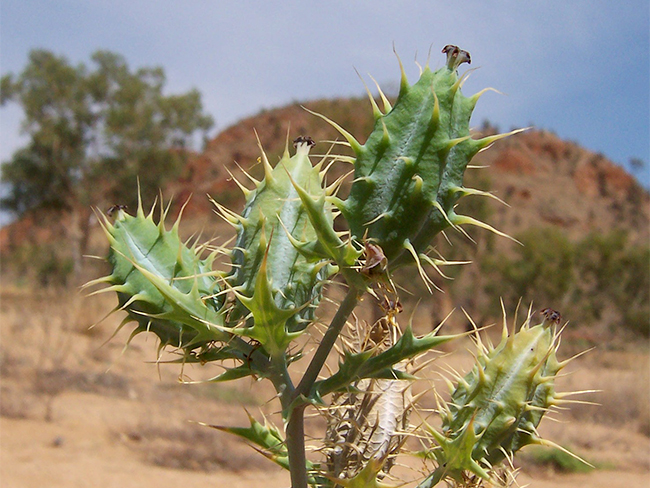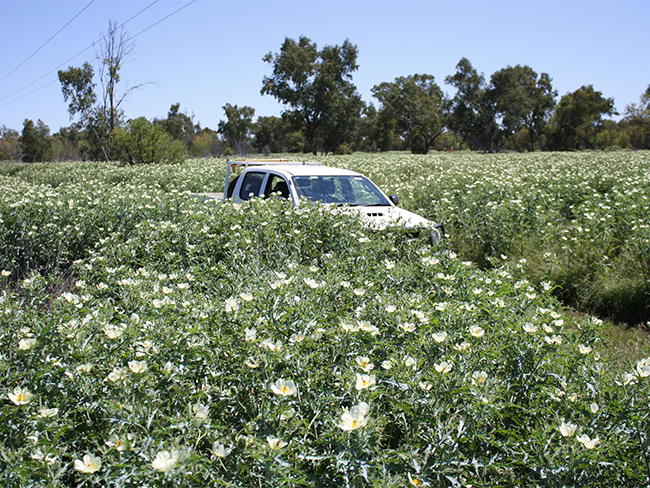Mexican poppy
Scientific name: Argemone ochroleuca
Declaration status: Class B
Mexican poppy is native to Mexico, but also occurs naturally in Texas and Central America.
It was introduced to Australia accidentally in the early 1800s possibly as a contaminant in wheat seed.
It generally establishes on disturbed ground, spreading along roadsides, riverbanks, sandy flats and the beds of intermittent streams.
It was first recorded in Australia in 1845. It has since become troublesome in Queensland, New South Wales, and Western Australia.
In the Northern Territory (NT), Mexican poppy is now well established throughout multiple central Australian river systems and there are scattered infestations on the road and rail corridors.
It prefers subtropical and semi-arid climates where it can grow on a wide range of soil types, especially those that keep high moisture during summer.
Impact
Mexican poppy can have all of the following impacts:
- all parts of the plant are toxic to humans and animals but it is generally avoided
- can compete with crops and pastures
- can contaminate feed and poison poultry and other livestock
- rapidly invades disturbed country
- proliferates in dry river beds affecting amenity
- impacts tourism, camping and recreational use of creeks and rivers.
Identification
You should use this as a guide. There may be other plants or weeds that look similar.
- up to 1m tall found in seasonal creeks, streambeds, drainage lines and disturbed areas
- smooth branches covered with stiff yellow prickles, release a yellow sap when cut
- distinctive pale blue-green leaves folded into multiple points ending in stiff yellow prickles
- single flowers at the end of branchlets, four to six cream-pale yellow petals, about 6cm across
- fruit are shiny blue-green capsules, covered in rigid spines, opening at the top to expose seeds
- each capsule contains up to 400 brown-black seeds 1.5mm in diameter
To find out more, get the Mexican poppy weed note on the Department of Environment, Parks and Water Security website.
If you are unsure, contact the Weed Management Branch.
Control
Chemical control
The best time to treat Mexican poppy is from December to February. Below is a list of chemicals and treatment methods that can be used.
| Chemical and concentration | Rate | Situation, method and notes |
|---|---|---|
|
2, 4-D amine 625 g/L Various trade names | 320ml / 100 L |
Seedling or adult (individuals or infestation): Foliar spray - apply when actively growing |
|
Glyphosate 360 g/L Various trade names and formulations | 10ml /1 L |
Seedling or adult (individuals or infestation): Foliar spray - apply when actively growing |
|
MCPA 340 g/L + Dicamba 80 g/L Various trade names | 350ml / 10 0L |
Seedling or adult (individuals or infestation): Foliar spray |
Non-chemical control
Non-chemical control aims to limit the production and spreading of seeds. Seeds stay dormant in the soil for up to seven years, so getting rid of the weed needs regular follow up control for several years.
Hand pulling and grubbing
Weeds, including their roots, are physically pulled out of the ground by hand or using hand tools. This is an effective method of control for individual weeds and recent outbreaks that haven’t released seeds yet, but it requires a lot of labour.
Take extra precautions to stop seed spread if removal is required once the plants are already seeding.
Spread
Mexican poppy is only propagated by seed, which tend to fall near the parent plant, sometimes leading to dense, almost pure stands, but they can be spread by water.
Accidental spread is a problem, through the transfer of contaminated construction materials Inadvertent transport of seed has occurred from river sand extracted from the numerous sand mining extraction licences established in the Todd River and Roe Creek as well as the points of sale of river sand used primarily for construction and back filling.
Users of construction and landscaping products should be aware of the potential for weed spread and establishment.
In central Australia new infestations of Mexican poppy have recently developed in areas where river sand and gravel have been used for landscaping and construction purposes.
Spread prevention
You can prevent the spread of Mexican poppy by doing all of the following:
- ask your supplier if the products to be provided are weed free
- avoid suppliers who have previously provided contaminated product
- cover or limit your load to avoid spillage during transport
- keep material contained and make sure no material stays on site
- map infestations to help develop a management plan
- report and manage any new outbreaks immediately
- designate wash down areas and actively work to prevent contamination of clean areas
- monitor all areas which have had river sand or gravel introduced
- monitor areas that you have treated and watch for re-infestations.
Give feedback about this page.
Share this page:
URL copied!
